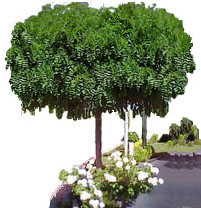|
Mop Tops maintain their round topiary shape without regular
trimming. |
When children draw a landscape or picture, the trees are often a lovely
round green ball on a tall straight trunk. In 1985 Chris Lucas realised that he could
create
 the fantasy ball on a stick tree by grafting a rare dwarf form
of Robinia onto a tall straight Robinia under stock. Chris named his new tree a Mop Top. the fantasy ball on a stick tree by grafting a rare dwarf form
of Robinia onto a tall straight Robinia under stock. Chris named his new tree a Mop Top.
The amazing thing about a Mop Top is that when you purchase these trees
they average five to seven feet tall and they grow to become quite thick with a lush,
rounded bushy head within twelve months of planting. The great beauty of the Mop Top is
that they maintain their round topiary shape without regular trimming.
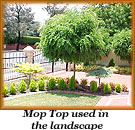 They naturally grow into a dense round ball and never grow more
than 4-5 metres tall. The reason for producing this tree by grafting a branch from a dwarf
Robinia called Robinia umbraculifera onto a hardy vigorous Robinia under stock is that
each Mop Top is then genetically cloned and has an identical head. If one were to plant a
multiple planting of Mop Tops that were all planted in the same soil and light conditions
and given similar amounts of moisture and nutrients you will find that they will all grow
identically. They naturally grow into a dense round ball and never grow more
than 4-5 metres tall. The reason for producing this tree by grafting a branch from a dwarf
Robinia called Robinia umbraculifera onto a hardy vigorous Robinia under stock is that
each Mop Top is then genetically cloned and has an identical head. If one were to plant a
multiple planting of Mop Tops that were all planted in the same soil and light conditions
and given similar amounts of moisture and nutrients you will find that they will all grow
identically.
|
Mop Tops are a totally unique landscape tool. |
Mop Tops are a totally unique landscape tool. They are cheap to produce and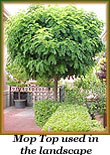 as a consequence are very economical to purchase, when compared to other standard or
topiary trees. They require little maintenance to maintain a lovely classical manicured
look.
as a consequence are very economical to purchase, when compared to other standard or
topiary trees. They require little maintenance to maintain a lovely classical manicured
look.
The Mop Top is very hardy coping well with wind, heat, drought, frost,
pollution and poor soils.
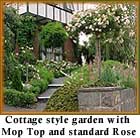 Because the Mop Top naturally grows small it is
ideal for planting in confined areas or creating avenues in places where conventional
trees won’t fit. Because the Mop Top naturally grows small it is
ideal for planting in confined areas or creating avenues in places where conventional
trees won’t fit.
One popular landscape concept with Mop Tops is to plant them along your
fence line to create a privacy screen above the fence, yet leave room for a colourful
under planting. Mop Tops are deep-rooted legumes that allow grass, flowers and shrubs to
thrive around their base.
Mop Tops look best when the head is young and small and very dense. After a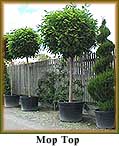 few years their head can get a little large or open, if this occurs
cut you Mop Top back very hard, you can use a saw or large trimmers.
Prune your Mop Top
few years their head can get a little large or open, if this occurs
cut you Mop Top back very hard, you can use a saw or large trimmers.
Prune your Mop Top
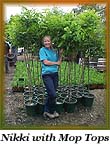 back
in winter and you will have a fresh lush new head by late spring. back
in winter and you will have a fresh lush new head by late spring.
Normally you would only have to cut back your Mop Tops every
few years. If you are growing your Mop Tops in a very confined area you can keep them
small by pruning hard every year.
Mop Tops are very hardy but they are not indestructible. When planting your
Mop Tops they require plenty of sunshine and moderate to good drainage. Don’t plant
them in the shade of trees or buildings and don’t plant them in compacted or swampy
sites.
Mop Tops look best when the head is young and
small and very dense. |
|
